Depression Among International Students: A Sociology Essay Analysis
VerifiedAdded on 2022/10/16
|6
|1459
|233
Essay
AI Summary
This sociology essay delves into the prevalent issue of depression among international students, particularly in Canada. It identifies language barriers, cultural differences, and feelings of isolation as primary contributing factors. The essay explores sociological theories like structural strain and differential association to understand the pressures faced by these students. It highlights the need for improved mental health support systems within universities, including counseling services, supportive campaigns, and fostering a welcoming environment. The essay also emphasizes the importance of communication, cultural training programs, physical activities, and self-talk to mitigate depression and promote the well-being of international students. It concludes by underscoring the significance of addressing these challenges to ensure a healthier and more inclusive academic experience.

NAME:
STUDENT NUMBER :
TITLE : SOCIOLOGY
WORD COUNT: 1000
STUDENT NUMBER :
TITLE : SOCIOLOGY
WORD COUNT: 1000
Paraphrase This Document
Need a fresh take? Get an instant paraphrase of this document with our AI Paraphraser
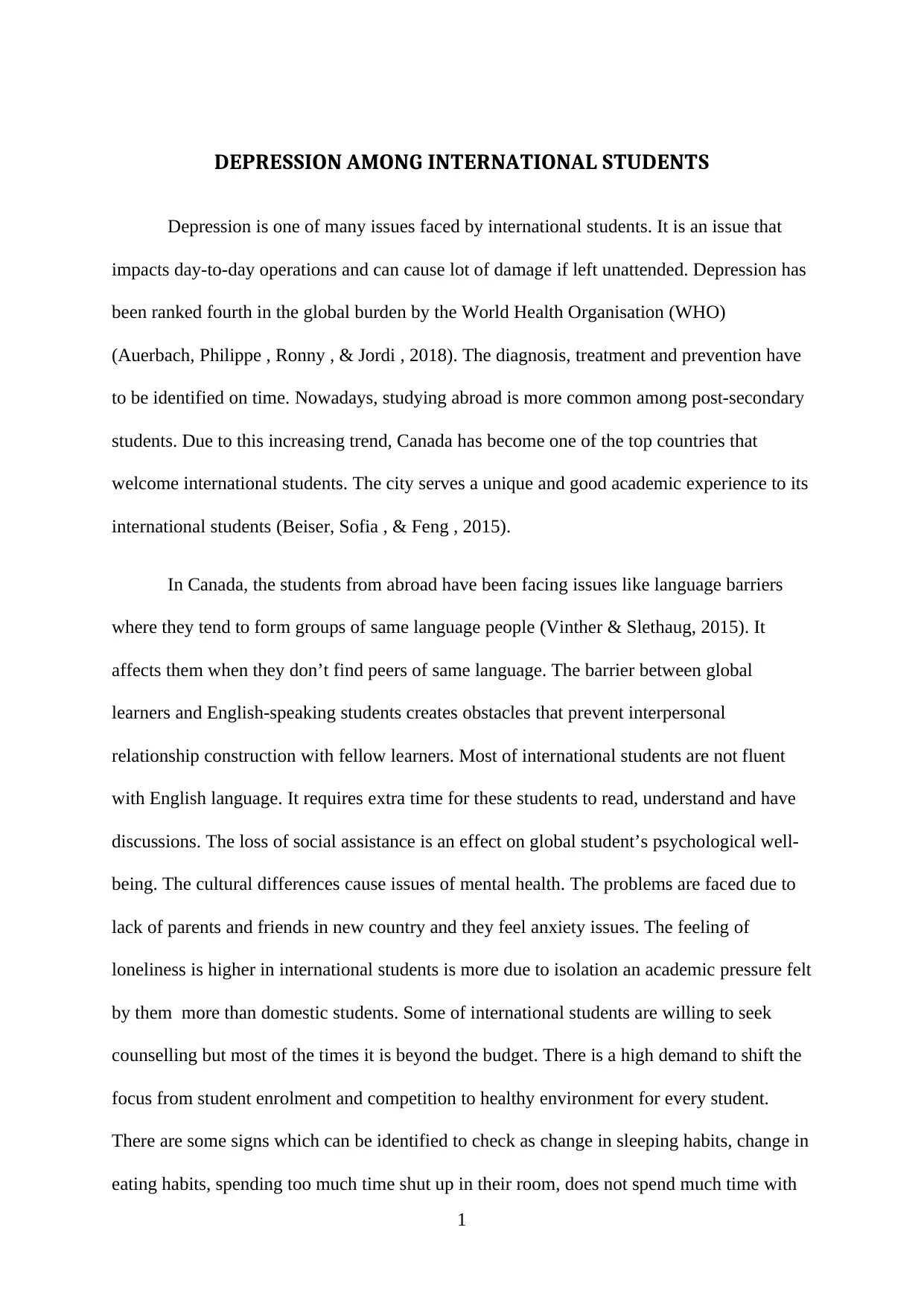
DEPRESSION AMONG INTERNATIONAL STUDENTS
Depression is one of many issues faced by international students. It is an issue that
impacts day-to-day operations and can cause lot of damage if left unattended. Depression has
been ranked fourth in the global burden by the World Health Organisation (WHO)
(Auerbach, Philippe , Ronny , & Jordi , 2018). The diagnosis, treatment and prevention have
to be identified on time. Nowadays, studying abroad is more common among post-secondary
students. Due to this increasing trend, Canada has become one of the top countries that
welcome international students. The city serves a unique and good academic experience to its
international students (Beiser, Sofia , & Feng , 2015).
In Canada, the students from abroad have been facing issues like language barriers
where they tend to form groups of same language people (Vinther & Slethaug, 2015). It
affects them when they don’t find peers of same language. The barrier between global
learners and English-speaking students creates obstacles that prevent interpersonal
relationship construction with fellow learners. Most of international students are not fluent
with English language. It requires extra time for these students to read, understand and have
discussions. The loss of social assistance is an effect on global student’s psychological well-
being. The cultural differences cause issues of mental health. The problems are faced due to
lack of parents and friends in new country and they feel anxiety issues. The feeling of
loneliness is higher in international students is more due to isolation an academic pressure felt
by them more than domestic students. Some of international students are willing to seek
counselling but most of the times it is beyond the budget. There is a high demand to shift the
focus from student enrolment and competition to healthy environment for every student.
There are some signs which can be identified to check as change in sleeping habits, change in
eating habits, spending too much time shut up in their room, does not spend much time with
1
Depression is one of many issues faced by international students. It is an issue that
impacts day-to-day operations and can cause lot of damage if left unattended. Depression has
been ranked fourth in the global burden by the World Health Organisation (WHO)
(Auerbach, Philippe , Ronny , & Jordi , 2018). The diagnosis, treatment and prevention have
to be identified on time. Nowadays, studying abroad is more common among post-secondary
students. Due to this increasing trend, Canada has become one of the top countries that
welcome international students. The city serves a unique and good academic experience to its
international students (Beiser, Sofia , & Feng , 2015).
In Canada, the students from abroad have been facing issues like language barriers
where they tend to form groups of same language people (Vinther & Slethaug, 2015). It
affects them when they don’t find peers of same language. The barrier between global
learners and English-speaking students creates obstacles that prevent interpersonal
relationship construction with fellow learners. Most of international students are not fluent
with English language. It requires extra time for these students to read, understand and have
discussions. The loss of social assistance is an effect on global student’s psychological well-
being. The cultural differences cause issues of mental health. The problems are faced due to
lack of parents and friends in new country and they feel anxiety issues. The feeling of
loneliness is higher in international students is more due to isolation an academic pressure felt
by them more than domestic students. Some of international students are willing to seek
counselling but most of the times it is beyond the budget. There is a high demand to shift the
focus from student enrolment and competition to healthy environment for every student.
There are some signs which can be identified to check as change in sleeping habits, change in
eating habits, spending too much time shut up in their room, does not spend much time with
1
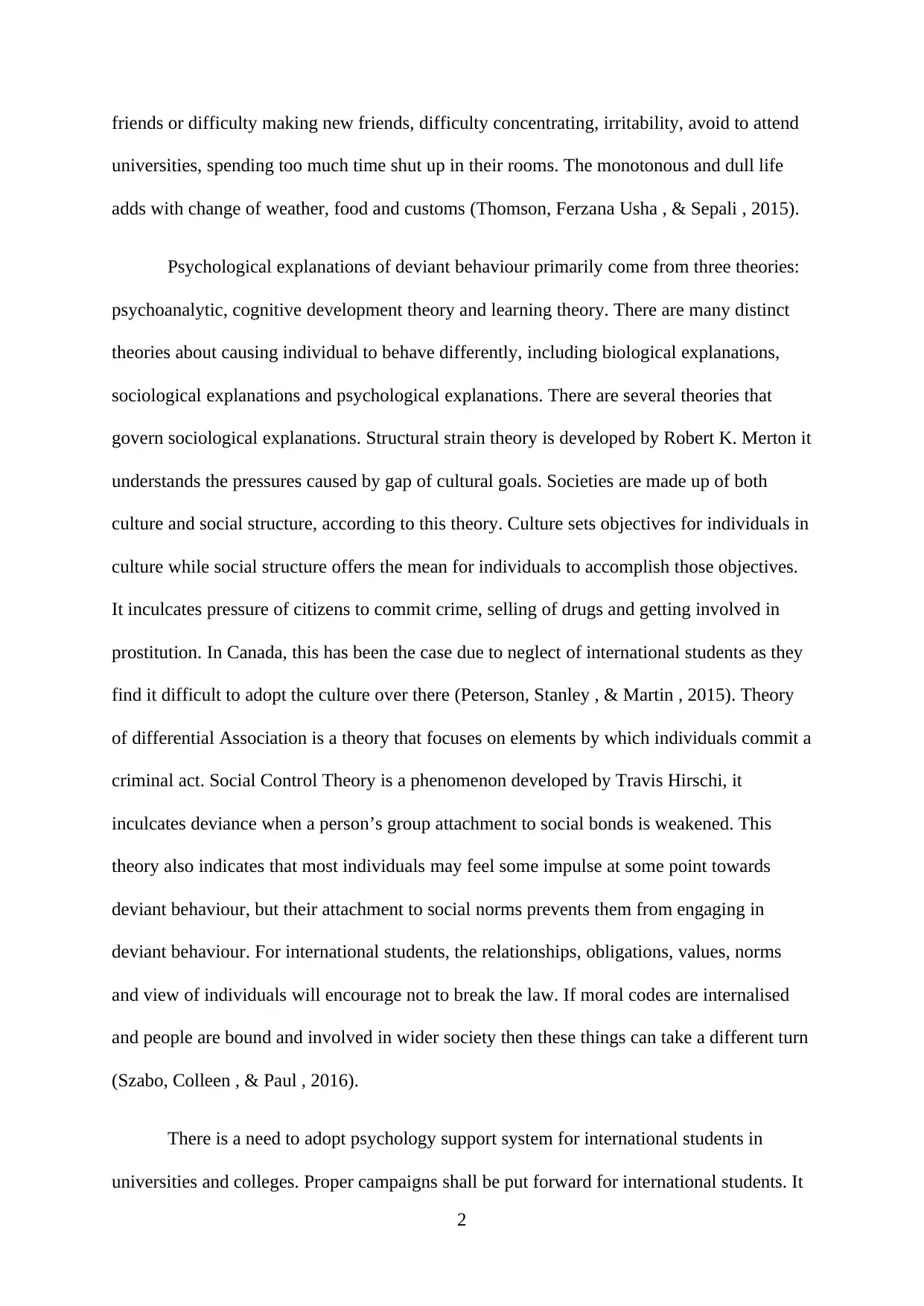
friends or difficulty making new friends, difficulty concentrating, irritability, avoid to attend
universities, spending too much time shut up in their rooms. The monotonous and dull life
adds with change of weather, food and customs (Thomson, Ferzana Usha , & Sepali , 2015).
Psychological explanations of deviant behaviour primarily come from three theories:
psychoanalytic, cognitive development theory and learning theory. There are many distinct
theories about causing individual to behave differently, including biological explanations,
sociological explanations and psychological explanations. There are several theories that
govern sociological explanations. Structural strain theory is developed by Robert K. Merton it
understands the pressures caused by gap of cultural goals. Societies are made up of both
culture and social structure, according to this theory. Culture sets objectives for individuals in
culture while social structure offers the mean for individuals to accomplish those objectives.
It inculcates pressure of citizens to commit crime, selling of drugs and getting involved in
prostitution. In Canada, this has been the case due to neglect of international students as they
find it difficult to adopt the culture over there (Peterson, Stanley , & Martin , 2015). Theory
of differential Association is a theory that focuses on elements by which individuals commit a
criminal act. Social Control Theory is a phenomenon developed by Travis Hirschi, it
inculcates deviance when a person’s group attachment to social bonds is weakened. This
theory also indicates that most individuals may feel some impulse at some point towards
deviant behaviour, but their attachment to social norms prevents them from engaging in
deviant behaviour. For international students, the relationships, obligations, values, norms
and view of individuals will encourage not to break the law. If moral codes are internalised
and people are bound and involved in wider society then these things can take a different turn
(Szabo, Colleen , & Paul , 2016).
There is a need to adopt psychology support system for international students in
universities and colleges. Proper campaigns shall be put forward for international students. It
2
universities, spending too much time shut up in their rooms. The monotonous and dull life
adds with change of weather, food and customs (Thomson, Ferzana Usha , & Sepali , 2015).
Psychological explanations of deviant behaviour primarily come from three theories:
psychoanalytic, cognitive development theory and learning theory. There are many distinct
theories about causing individual to behave differently, including biological explanations,
sociological explanations and psychological explanations. There are several theories that
govern sociological explanations. Structural strain theory is developed by Robert K. Merton it
understands the pressures caused by gap of cultural goals. Societies are made up of both
culture and social structure, according to this theory. Culture sets objectives for individuals in
culture while social structure offers the mean for individuals to accomplish those objectives.
It inculcates pressure of citizens to commit crime, selling of drugs and getting involved in
prostitution. In Canada, this has been the case due to neglect of international students as they
find it difficult to adopt the culture over there (Peterson, Stanley , & Martin , 2015). Theory
of differential Association is a theory that focuses on elements by which individuals commit a
criminal act. Social Control Theory is a phenomenon developed by Travis Hirschi, it
inculcates deviance when a person’s group attachment to social bonds is weakened. This
theory also indicates that most individuals may feel some impulse at some point towards
deviant behaviour, but their attachment to social norms prevents them from engaging in
deviant behaviour. For international students, the relationships, obligations, values, norms
and view of individuals will encourage not to break the law. If moral codes are internalised
and people are bound and involved in wider society then these things can take a different turn
(Szabo, Colleen , & Paul , 2016).
There is a need to adopt psychology support system for international students in
universities and colleges. Proper campaigns shall be put forward for international students. It
2
⊘ This is a preview!⊘
Do you want full access?
Subscribe today to unlock all pages.

Trusted by 1+ million students worldwide
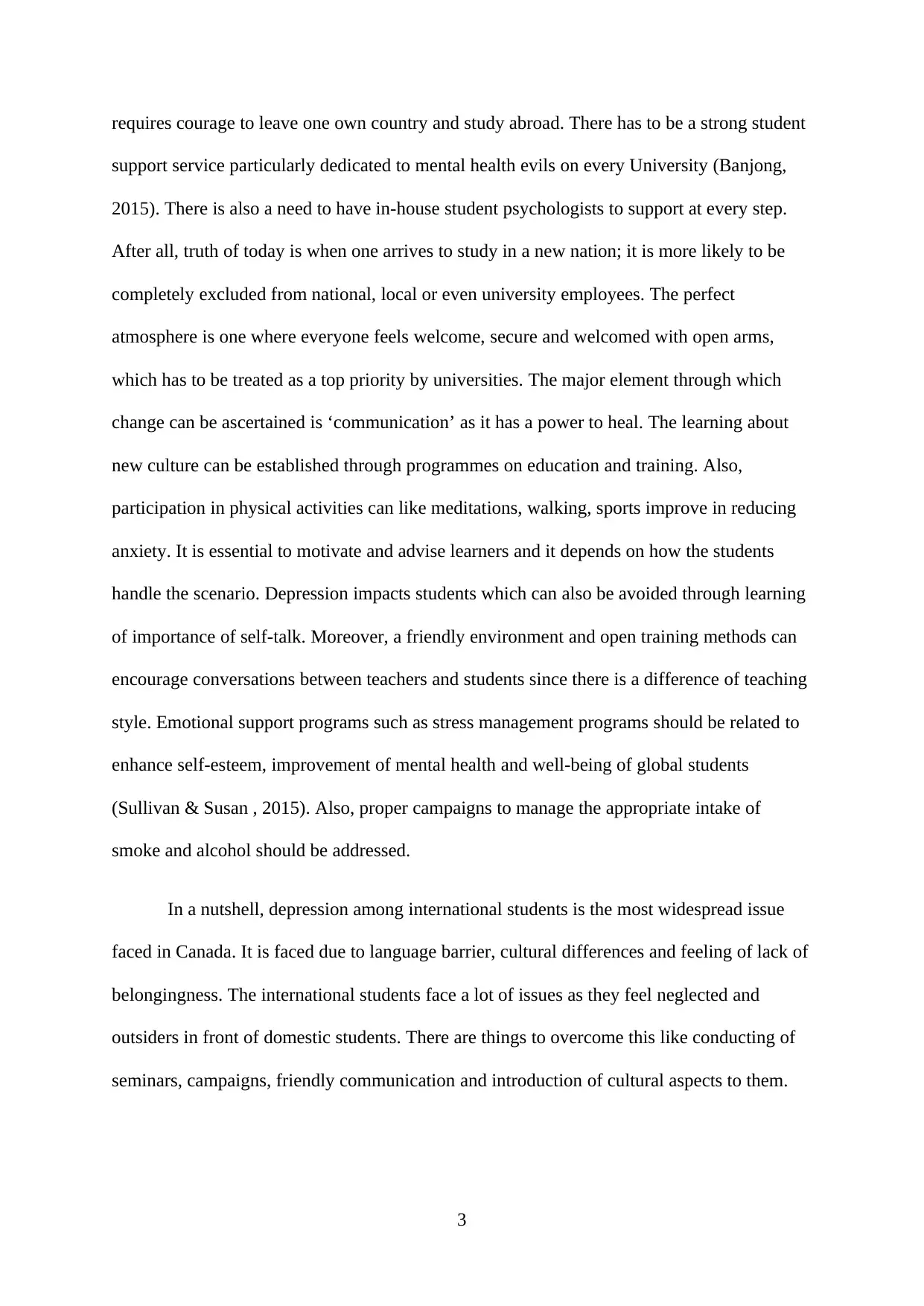
requires courage to leave one own country and study abroad. There has to be a strong student
support service particularly dedicated to mental health evils on every University (Banjong,
2015). There is also a need to have in-house student psychologists to support at every step.
After all, truth of today is when one arrives to study in a new nation; it is more likely to be
completely excluded from national, local or even university employees. The perfect
atmosphere is one where everyone feels welcome, secure and welcomed with open arms,
which has to be treated as a top priority by universities. The major element through which
change can be ascertained is ‘communication’ as it has a power to heal. The learning about
new culture can be established through programmes on education and training. Also,
participation in physical activities can like meditations, walking, sports improve in reducing
anxiety. It is essential to motivate and advise learners and it depends on how the students
handle the scenario. Depression impacts students which can also be avoided through learning
of importance of self-talk. Moreover, a friendly environment and open training methods can
encourage conversations between teachers and students since there is a difference of teaching
style. Emotional support programs such as stress management programs should be related to
enhance self-esteem, improvement of mental health and well-being of global students
(Sullivan & Susan , 2015). Also, proper campaigns to manage the appropriate intake of
smoke and alcohol should be addressed.
In a nutshell, depression among international students is the most widespread issue
faced in Canada. It is faced due to language barrier, cultural differences and feeling of lack of
belongingness. The international students face a lot of issues as they feel neglected and
outsiders in front of domestic students. There are things to overcome this like conducting of
seminars, campaigns, friendly communication and introduction of cultural aspects to them.
3
support service particularly dedicated to mental health evils on every University (Banjong,
2015). There is also a need to have in-house student psychologists to support at every step.
After all, truth of today is when one arrives to study in a new nation; it is more likely to be
completely excluded from national, local or even university employees. The perfect
atmosphere is one where everyone feels welcome, secure and welcomed with open arms,
which has to be treated as a top priority by universities. The major element through which
change can be ascertained is ‘communication’ as it has a power to heal. The learning about
new culture can be established through programmes on education and training. Also,
participation in physical activities can like meditations, walking, sports improve in reducing
anxiety. It is essential to motivate and advise learners and it depends on how the students
handle the scenario. Depression impacts students which can also be avoided through learning
of importance of self-talk. Moreover, a friendly environment and open training methods can
encourage conversations between teachers and students since there is a difference of teaching
style. Emotional support programs such as stress management programs should be related to
enhance self-esteem, improvement of mental health and well-being of global students
(Sullivan & Susan , 2015). Also, proper campaigns to manage the appropriate intake of
smoke and alcohol should be addressed.
In a nutshell, depression among international students is the most widespread issue
faced in Canada. It is faced due to language barrier, cultural differences and feeling of lack of
belongingness. The international students face a lot of issues as they feel neglected and
outsiders in front of domestic students. There are things to overcome this like conducting of
seminars, campaigns, friendly communication and introduction of cultural aspects to them.
3
Paraphrase This Document
Need a fresh take? Get an instant paraphrase of this document with our AI Paraphraser
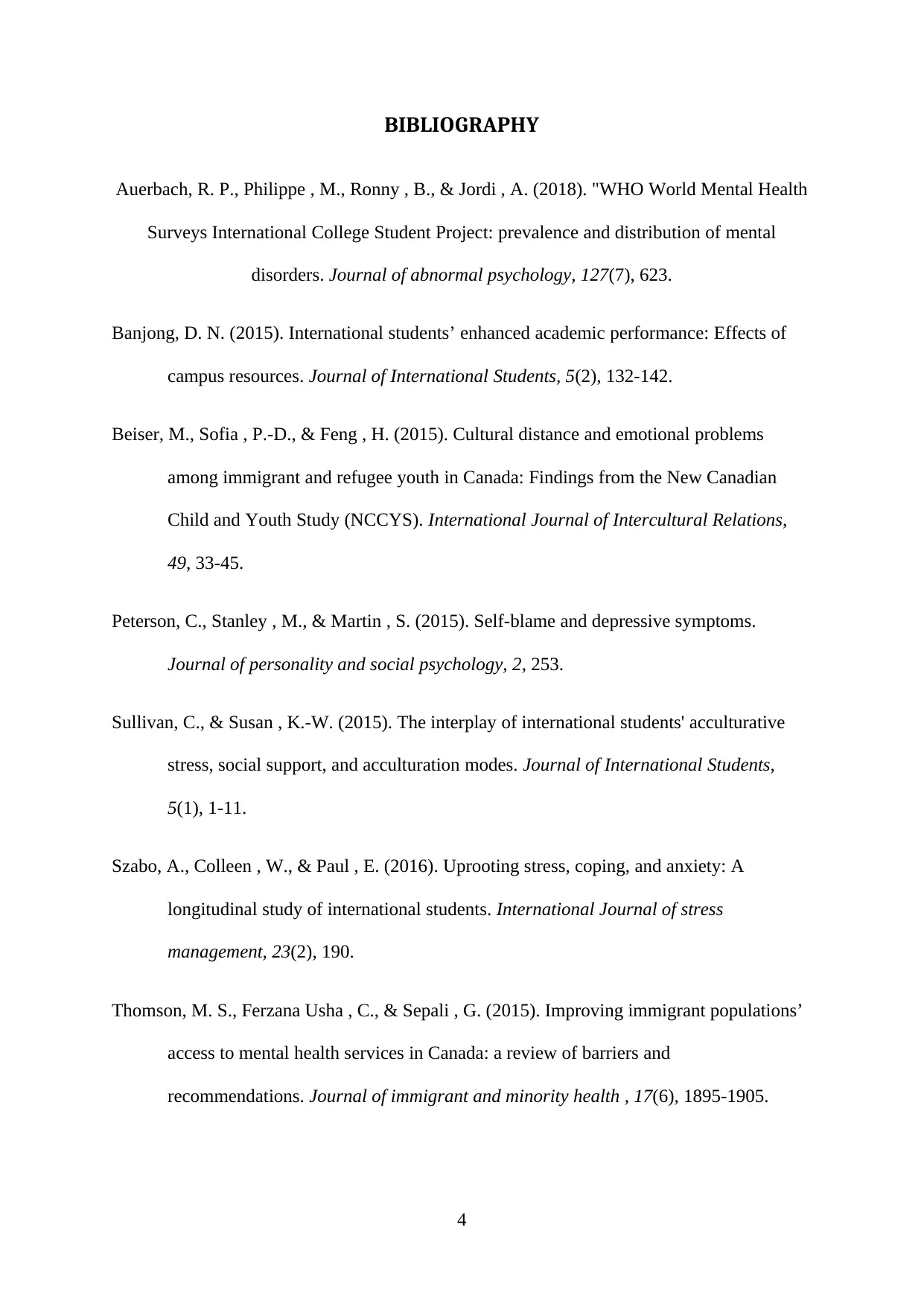
BIBLIOGRAPHY
Auerbach, R. P., Philippe , M., Ronny , B., & Jordi , A. (2018). "WHO World Mental Health
Surveys International College Student Project: prevalence and distribution of mental
disorders. Journal of abnormal psychology, 127(7), 623.
Banjong, D. N. (2015). International students’ enhanced academic performance: Effects of
campus resources. Journal of International Students, 5(2), 132-142.
Beiser, M., Sofia , P.-D., & Feng , H. (2015). Cultural distance and emotional problems
among immigrant and refugee youth in Canada: Findings from the New Canadian
Child and Youth Study (NCCYS). International Journal of Intercultural Relations,
49, 33-45.
Peterson, C., Stanley , M., & Martin , S. (2015). Self-blame and depressive symptoms.
Journal of personality and social psychology, 2, 253.
Sullivan, C., & Susan , K.-W. (2015). The interplay of international students' acculturative
stress, social support, and acculturation modes. Journal of International Students,
5(1), 1-11.
Szabo, A., Colleen , W., & Paul , E. (2016). Uprooting stress, coping, and anxiety: A
longitudinal study of international students. International Journal of stress
management, 23(2), 190.
Thomson, M. S., Ferzana Usha , C., & Sepali , G. (2015). Improving immigrant populations’
access to mental health services in Canada: a review of barriers and
recommendations. Journal of immigrant and minority health , 17(6), 1895-1905.
4
Auerbach, R. P., Philippe , M., Ronny , B., & Jordi , A. (2018). "WHO World Mental Health
Surveys International College Student Project: prevalence and distribution of mental
disorders. Journal of abnormal psychology, 127(7), 623.
Banjong, D. N. (2015). International students’ enhanced academic performance: Effects of
campus resources. Journal of International Students, 5(2), 132-142.
Beiser, M., Sofia , P.-D., & Feng , H. (2015). Cultural distance and emotional problems
among immigrant and refugee youth in Canada: Findings from the New Canadian
Child and Youth Study (NCCYS). International Journal of Intercultural Relations,
49, 33-45.
Peterson, C., Stanley , M., & Martin , S. (2015). Self-blame and depressive symptoms.
Journal of personality and social psychology, 2, 253.
Sullivan, C., & Susan , K.-W. (2015). The interplay of international students' acculturative
stress, social support, and acculturation modes. Journal of International Students,
5(1), 1-11.
Szabo, A., Colleen , W., & Paul , E. (2016). Uprooting stress, coping, and anxiety: A
longitudinal study of international students. International Journal of stress
management, 23(2), 190.
Thomson, M. S., Ferzana Usha , C., & Sepali , G. (2015). Improving immigrant populations’
access to mental health services in Canada: a review of barriers and
recommendations. Journal of immigrant and minority health , 17(6), 1895-1905.
4
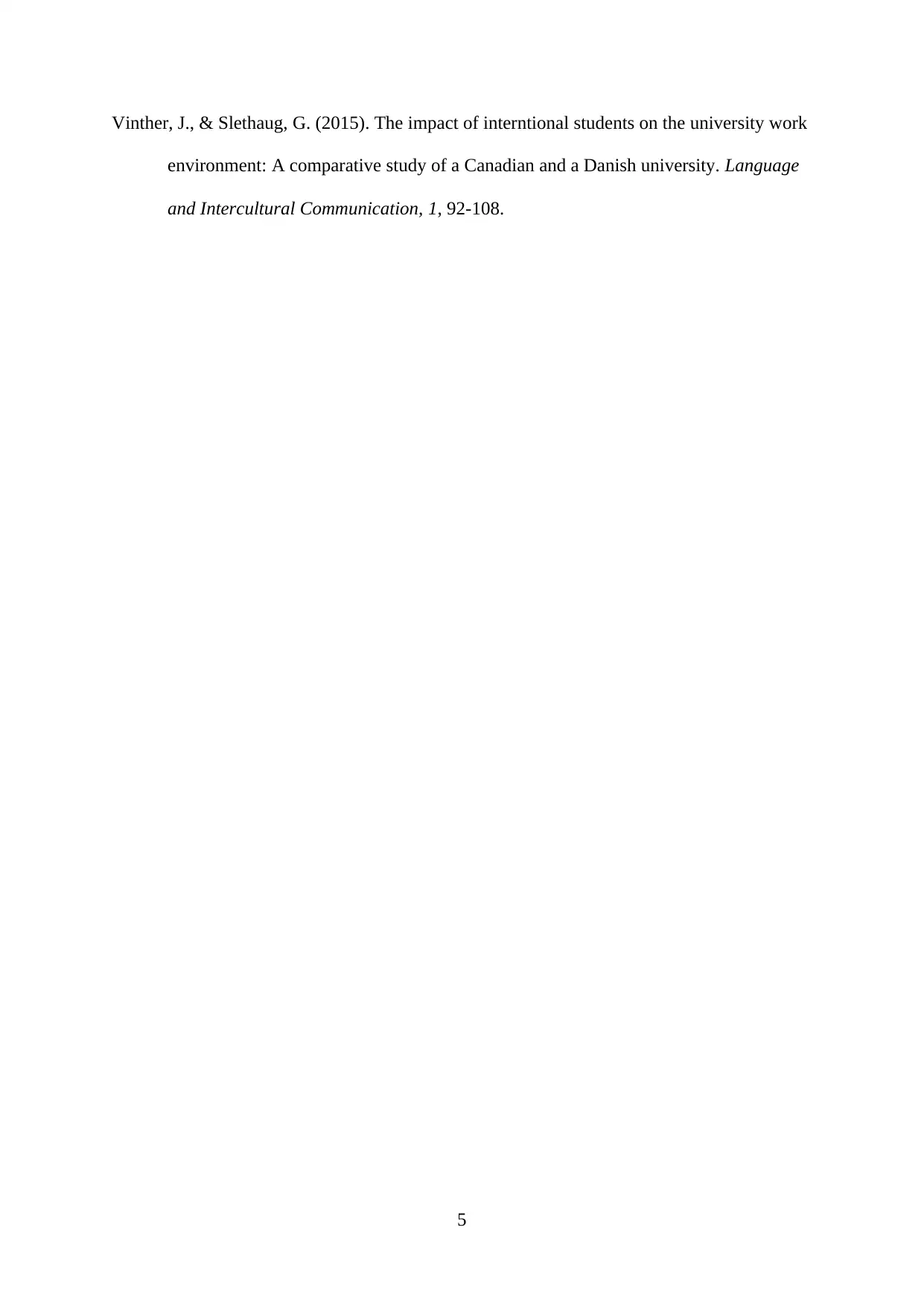
Vinther, J., & Slethaug, G. (2015). The impact of interntional students on the university work
environment: A comparative study of a Canadian and a Danish university. Language
and Intercultural Communication, 1, 92-108.
5
environment: A comparative study of a Canadian and a Danish university. Language
and Intercultural Communication, 1, 92-108.
5
⊘ This is a preview!⊘
Do you want full access?
Subscribe today to unlock all pages.

Trusted by 1+ million students worldwide
1 out of 6
Related Documents
Your All-in-One AI-Powered Toolkit for Academic Success.
+13062052269
info@desklib.com
Available 24*7 on WhatsApp / Email
![[object Object]](/_next/static/media/star-bottom.7253800d.svg)
Unlock your academic potential
Copyright © 2020–2025 A2Z Services. All Rights Reserved. Developed and managed by ZUCOL.




